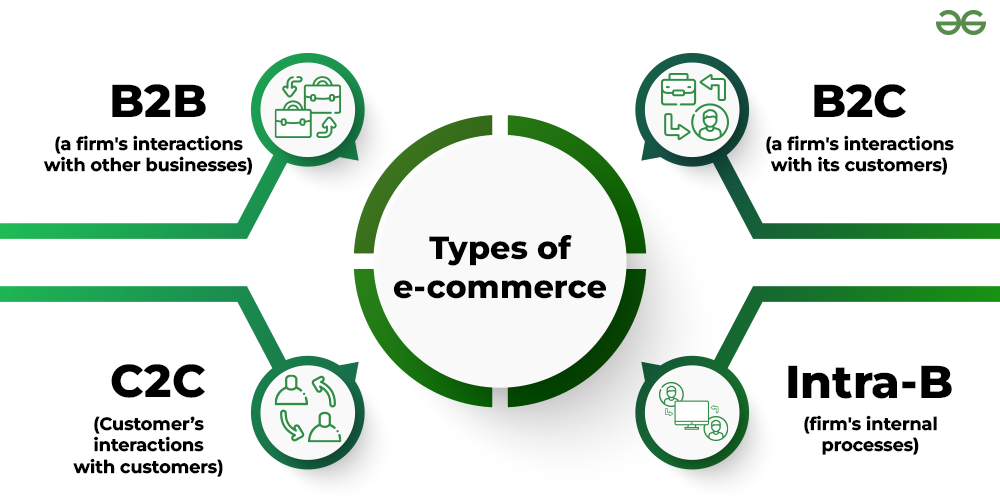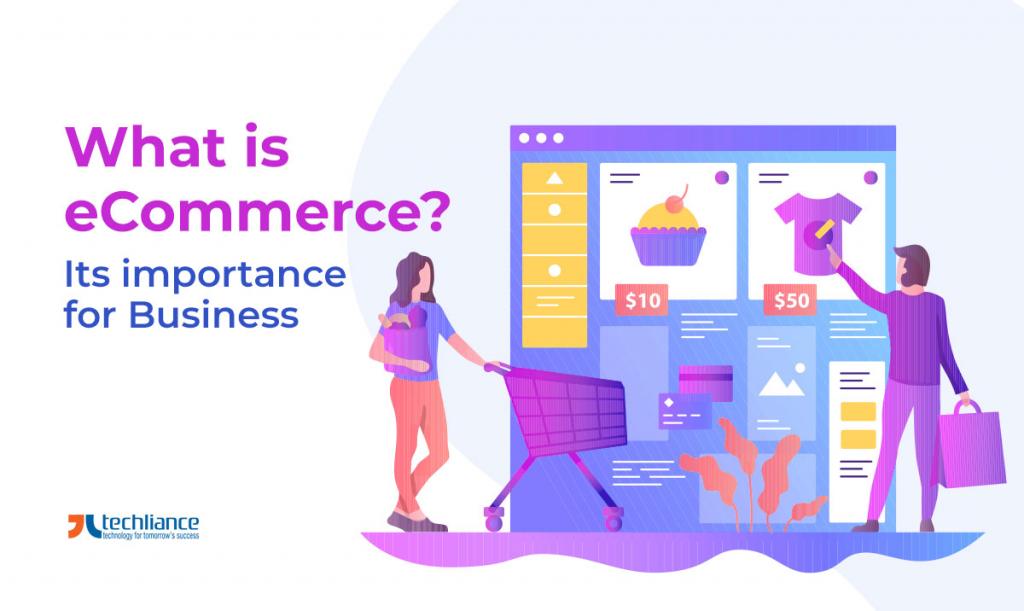whats is e commerce

E-commerce, short for electronic commerce, is revolutionizing the way businesses operate and consumers shop. With the rapid advancement of technology and the widespread use of the internet, e-commerce has emerged as a powerful tool that allows individuals and companies to buy and sell products or services online. It has become an integral part of our daily lives, offering convenience, accessibility, and endless possibilities for both buyers and sellers.
In its simplest form, e-commerce involves conducting any commercial transactions through electronic means. This can include online shopping websites where customers can browse products, add them to their virtual carts, make payments online using various secure payment methods, and have their purchases delivered right to their doorstep.
What is e-commerce and its significance?

E-commerce, short for electronic commerce, is the buying and selling of goods and services over the internet. It involves online shopping platforms where businesses can showcase their products or services to potential customers who can then make purchases using various payment methods. E-commerce has gained immense popularity in recent years due to its convenience and accessibility. One significant aspect of e-commerce is its global reach. With e-commerce, businesses are no longer limited by geographical boundaries as they can now sell their products or services to consumers around the world. This opens up a vast market of potential customers and allows businesses to expand their customer base significantly. Another crucial significance of e-commerce is its ability to provide a personalized shopping experience for customers. Through advanced technologies like artificial intelligence and data analytics, e-commerce platforms can track customer preferences and tailor product recommendations accordingly. This not only enhances customer satisfaction but also helps businesses in targeted marketing strategies and increasing sales.
Overall, e-commerce has revolutionized the way businesses operate by providing them with an efficient platform that enables them to reach a wider audience while offering personalized experiences for customers. Its significance lies in its ability to boost sales, increase brand exposure globally, and streamline the overall shopping experience through technological advancements.
Definition: Understanding the concept of e-commerce.
E-commerce, short for electronic commerce, refers to the buying and selling of products or services over the internet. It involves conducting transactions electronically, without the need for physical presence or a traditional brick-and-mortar store. E-commerce has revolutionized the way businesses operate and changed consumer behavior worldwide. The concept of e-commerce encompasses several key elements. Firstly, it involves online shopping platforms where customers can browse through various products or services and make purchases using electronic payment methods such as credit cards or digital wallets. Secondly, e-commerce includes online marketplaces like Amazon or eBay, which bring together multiple sellers and buyers on a single platform. These marketplaces provide consumers with access to an extensive range of products from different sellers in one convenient place.
Additionally, e-commerce also covers other aspects such as electronic banking and online auctions. Electronic banking enables individuals to manage their finances remotely through internet banking applications or mobile apps. Online auctions allow users to bid on items listed by sellers, often resulting in competitive pricing for unique goods.
Overall, understanding the concept of e-commerce is crucial in today’s digital age as it has transformed how businesses operate and created opportunities for global trade on a massive scale.
Types: Exploring various forms of e-commerce.
E-commerce, short for electronic commerce, refers to the buying and selling of goods and services over the internet. It has revolutionized the way people shop and conduct business, offering convenience, accessibility, and a global reach. With the advancement of technology, various forms of e-commerce have emerged to cater to different needs and preferences. One type of e-commerce is B2C (business-to-consumer), where businesses sell products directly to individual consumers through online platforms or websites. This form of e-commerce allows customers to browse through a wide range of products from different brands, compare prices, read reviews, and make purchases at their convenience. Popular examples include online retail giants like Amazon and eBay.
Another type is B2B (business-to-business) e-commerce which involves transactions between businesses rather than with individual customers. This could be seen in wholesale marketplaces or platforms that connect suppliers with retailers or manufacturers with distributors. B2B e-commerce streamlines procurement processes by providing a digital platform for businesses to source materials or components more efficiently.
Furthermore, as technology continues to advance rapidly, there are other emerging forms of e-commerce such as C2C (consumer-to-consumer) where individuals can sell products directly to other individuals through online marketplaces like Craigslist or Facebook Marketplace. Additionally, there is also m-commerce (mobile commerce) which focuses on conducting commercial transactions via mobile devices such as smartphones or tablets.
Benefits: Advantages of engaging in e-commerce.
E-commerce, or electronic commerce, refers to the buying and selling of goods and services over the internet. With the increasing popularity of online shopping, engaging in e-commerce offers numerous benefits and advantages for both businesses and consumers.
1.Firstly, e-commerce provides a global reach, allowing businesses to transcend geographical boundaries. This means that companies can expand their customer base beyond their local area or even national borders. By tapping into a wider market, businesses have the potential to increase sales and revenue significantly.
2.Secondly, e-commerce offers convenience to both businesses and consumers. For businesses, setting up an online store is relatively simple compared to establishing a physical retail space. Additionally, online stores are accessible 24/7, meaning that customers can browse and make purchases at any time that suits them. From a consumer perspective, shopping online eliminates the need for traveling to physical stores, saving time and effort.
3.Engaging in e-commerce often allows for cost savings. Businesses can reduce expenses associated with renting or owning physical store spaces as well as staffing requirements. E-commerce platforms also offer various tools for marketing automation and customer relationship management (CRM), enabling companies to streamline processes and cut down on operational costs.
Obstacles faced by e-commerce businesses.
E-commerce, also known as electronic commerce, refers to the buying and selling of goods and services over the internet. It has gained immense popularity in recent years due to its convenience and accessibility. However, like any other business model, e-commerce businesses also face several obstacles that can hinder their growth and success.
One major obstacle faced by e-commerce businesses is intense competition. With the increasing number of online marketplaces and platforms, businesses have to constantly strive to differentiate themselves from their competitors. This can be challenging as consumers have a wide range of options available at their fingertips, making it difficult for e-commerce businesses to stand out. Another obstacle is ensuring cybersecurity and protecting customer data. With the rise in online transactions, there is a corresponding increase in cybercrimes such as data breaches and hacking attempts. E-commerce businesses need to invest heavily in robust security measures to safeguard customer information and maintain trust with their audience.
Additionally, logistics and shipping pose significant challenges for e-commerce businesses. Efficient order fulfillment requires seamless coordination between inventory management systems, packaging processes, delivery partners, and timely notifications for customers. Any disruption or delay in this chain can negatively impact the reputation of an e-commerce business. Despite these obstacles, successful e-commerce businesses continually adapt to changing consumer preferences while prioritizing security measures and streamlining logistics operations to provide exceptional experiences for their customers online.
Current and future trends in e-commerce.
E-commerce refers to the buying and selling of goods and services over the internet. This form of business has gained significant traction in recent years, transforming the way people shop. One current trend in e-commerce is the rise of mobile shopping. With the increasing popularity of smartphones, consumers are now able to make purchases anytime and anywhere using their mobile devices. This shift towards mobile commerce has prompted businesses to optimize their websites and develop user-friendly mobile apps to cater to this growing segment. Another emerging trend in e-commerce is the integration of artificial intelligence (AI) technology. AI-powered chatbots are being utilized by many online retailers to enhance customer service by providing personalized recommendations, answering inquiries, and assisting with purchase decisions. Furthermore, machine learning algorithms are being used by e-commerce platforms to analyze customer data and predict buying patterns, allowing businesses to offer targeted promotions and improve overall customer experience.
Looking into the future, virtual reality (VR) holds great potential for revolutionizing e-commerce. VR technology can create immersive online shopping experiences where customers can virtually try on clothing or visualize furniture placement within their homes before making a purchase decision. Although still in its early stages, incorporating VR into e-commerce would bridge the gap between brick-and-mortar stores and online shopping by providing a more interactive and engaging platform for consumers.
Conclusion: The impact and potential of e-commerce.
In conclusion, e-commerce has revolutionized the way we shop and do business. Its convenience and accessibility have made it a popular choice for consumers all over the world. With the continuous advancements in technology, e-commerce is only expected to grow even further in the future. As more businesses embrace this digital platform, it is crucial for them to understand the importance of providing a seamless online shopping experience to their customers. Whether you are a consumer or a business owner, it is essential to stay informed and adapt to the ever-changing landscape of e-commerce. So why wait? Embrace e-commerce today and reap its numerous benefits!
ALSO READ / leveraging social media for student elections




